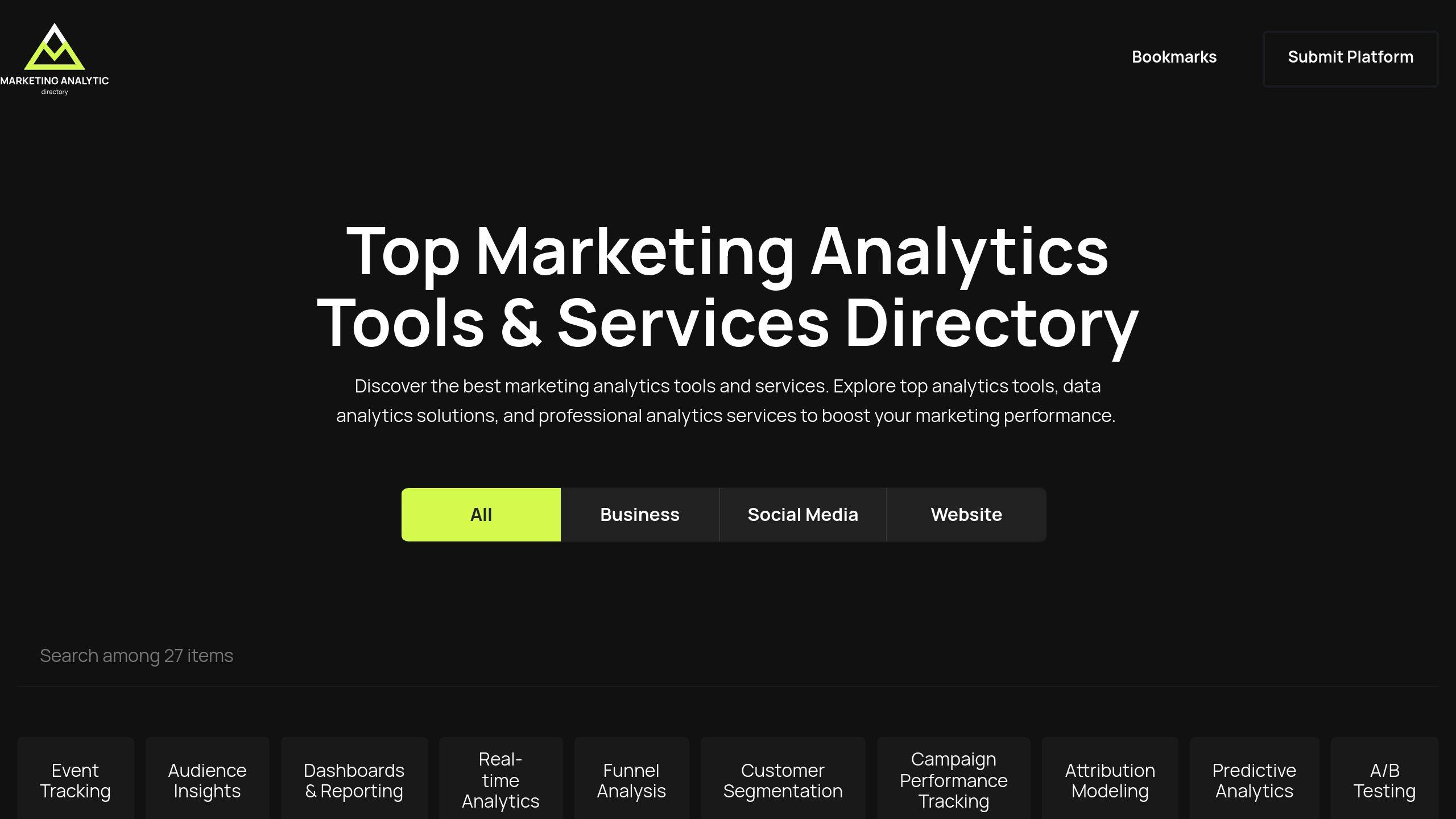Want to connect your marketing efforts directly to business success? Start by aligning your marketing KPIs with your business goals. This ensures you can measure progress, focus on what matters, and prove ROI. Here's how:
- Define Clear Business Objectives: Examples include increasing revenue, expanding markets, or improving customer retention.
- Set SMART KPIs: Make them Specific, Measurable, Attainable, Relevant, and Time-bound.
- Use Analytics Tools: Platforms like Google Analytics or HubSpot help track and analyze performance.
- Regularly Review and Adjust: Stay flexible by revisiting KPIs quarterly or as market conditions change.
Aligning KPIs ensures your marketing delivers measurable results while staying focused on your business goals. Ready to dive deeper? Let’s explore each step.
Aligning Marketing KPIs with Organizational Goals
Step 1: Clearly Define Business Objectives
Setting clear and specific business objectives is the first step to aligning them with relevant KPIs.
Examples of Business Objectives
Here are some common categories of business objectives, along with examples and ways to measure them:
| Objective Category | Specific Goal Example | Measurement Approach |
|---|---|---|
| Revenue Growth | Increase annual revenue by 25% | Track monthly revenue |
| Market Expansion | Enter 3 new geographic markets | Measure penetration rates |
| Customer Success | Improve retention rate to 85% | Use NPS (Net Promoter Score) |
| Brand Development | Achieve 40% brand recognition | Conduct surveys |
These goals act as benchmarks, ensuring that marketing KPIs are directly tied to your business's overall success.
Prioritizing Objectives
Focus on objectives that will have the most impact, considering your business's stage of growth and available resources. For example, startups might prioritize gaining market share and acquiring customers, while established businesses might emphasize retention and efficiency. Be realistic about what can be achieved with your financial and human resources [2].
As Intrafocus explains:
"KPI alignment with organisational goals isn't just a strategic move - it's a lifeline to success in today's complex business landscape." [2]
When prioritizing, take these into account:
- Market trends
- Competitor activity
- Economic conditions
Revisit your objectives every quarter or six months to ensure they remain relevant [2][4].
With clear business objectives in place, the next step is to turn them into actionable marketing KPIs.
Step 2: Convert Business Goals into Marketing KPIs
Selecting the Right KPIs
Take the business objectives from Step 1 and align each one with specific KPIs that measure progress clearly. Here's a breakdown of how business goals can connect to marketing KPIs:
| Business Goal | Primary KPIs | Supporting Metrics |
|---|---|---|
| Revenue Growth | Customer Acquisition Cost (CAC) | Lead-to-Customer Ratio |
| Market Expansion | Website Traffic by Region | Geographic Conversion Rates |
| Customer Success | Net Promoter Score (NPS) | Customer Lifetime Value |
| Brand Development | Social Media Engagement Rate | Brand Mention Volume |
When picking KPIs, focus on metrics that directly track progress toward your goals. For instance, if you aim to grow market share, monitor website traffic from specific regions along with conversion rates to gauge how well you're reaching new audiences.
Using the SMART Framework
The SMART framework helps ensure your KPIs are clear and realistic:
- Specific: Define precise metrics. For example, instead of saying "increase website traffic", specify "increase organic traffic from target regions."
- Measurable: Use numbers and quantifiable targets to track progress.
- Attainable: Set goals based on past data and available resources.
- Relevant: Make sure each KPI ties directly to your business goals. For example, if customer retention is your focus, prioritize metrics like repeat purchase rate over new visitor traffic.
- Time-bound: Assign deadlines to create urgency and allow for regular progress checks.
Stick to a focused set of KPIs directly tied to your most important goals. This keeps the process simple and actionable. To succeed, set up a reliable tracking system and ensure your team understands how their efforts impact these KPIs [1][3].
With your KPIs in place, the next step is to implement tools for tracking and analyzing performance.
sbb-itb-5174ba0
Step 3: Use Tools to Track and Analyze KPIs
Analytics tools help connect your KPIs to actionable insights, making sure your marketing efforts stay on track and deliver results. These platforms provide real-time data to ensure your strategies align with your business objectives.
Marketing Analytics Tools Directory

Looking for the right analytics platform? The Marketing Analytics Tools Directory can help you find tools designed for your specific KPI tracking needs, including real-time reporting, campaign performance analysis, and audience insights.
Choosing the Right Analytics Tools
Not all tools are created equal - each serves a specific purpose when it comes to tracking KPIs. Here’s a quick breakdown of how some popular platforms measure up:
| Tool Type | KPI Tracking Focus |
|---|---|
| Google Analytics | Monitors website traffic and conversion rates |
| HubSpot | Tracks lead quality metrics and campaign ROI |
| Tableau | Builds custom dashboards with predictive trend analysis |
When selecting a tool, keep these key factors in mind:
| Evaluation Criteria | Why It Matters |
|---|---|
| Data Integration | Combines all your data for a complete KPI overview |
| Scalability | Ensures the tool grows with your business |
| Customization | Lets you tailor tracking to your specific needs |
| Real-time Reporting | Helps you respond quickly to changes |
For the best results, look for tools that offer:
- Easy-to-understand data visualization
- Seamless integration with your current systems
- A user-friendly interface to encourage team adoption
- Automated reporting to save time
Once you’ve chosen the right tools, make it a habit to review and refine your KPIs regularly. This ensures they stay aligned with your changing business goals.
Step 4: Regularly Align and Adjust KPIs
Keeping KPIs relevant requires consistent feedback and fine-tuning. High-performing teams rely on structured reviews to gather insights and make necessary changes:
| Review Level | Frequency | Key Activities |
|---|---|---|
| Team Check-ins | Weekly | Analyze performance data, make quick adjustments |
| Department Review | Monthly | Align across teams, optimize resources |
| Strategic Assessment | Quarterly | Evaluate goals, make major KPI updates |
Key elements of effective feedback include:
- Weekly performance reviews to address immediate needs
- Input from various teams to ensure alignment across departments
- Using data to spot trends and adjust strategies accordingly
Analytics tools from Step 3 are critical here. Use them to gather and analyze data for both short-term and long-term reviews, enabling timely and informed decisions.
Responding to Market Changes
Markets evolve, and your KPIs need to keep up. Here’s how to handle key market shifts:
| Market Factor | Impact and Action |
|---|---|
| Competitive Shifts | Reevaluate benchmarks and update performance goals |
| Changes in Customer Behavior | Adjust tracking methods to capture new patterns |
| Emerging Industry Trends | Add KPIs that reflect new priorities or challenges |
Always document any changes to your KPIs. This ensures consistency, clarity, and accountability. The goal is to stay flexible and aligned with your business objectives while adapting to market demands [2].
Conclusion: Achieving Success Through Alignment
Connecting marketing KPIs to business goals ensures progress can be measured, resources are used wisely, and outcomes improve. This process requires consistent focus and periodic adjustments.
Key Points
The path to successful KPI alignment is built on four main pillars:
| Pillar | Purpose |
|---|---|
| Clear Business Objectives | Provides direction and focus |
| SMART KPIs | Makes progress measurable |
| Analytics Tools | Supports informed decision-making |
| Regular Reviews | Keeps goals and actions aligned |
This method highlights the importance of aligning KPIs to drive growth and use resources effectively. As noted in Step 3, analytics tools play a key role in monitoring and fine-tuning KPIs. Using these tools helps businesses keep their goals relevant and adaptable to shifting circumstances.
FAQs
How to set up marketing KPIs?
To create effective marketing KPIs, connect them directly to your business goals. Here's a quick breakdown:
| Step | Description | Key Consideration |
|---|---|---|
| Metric Selection | Pick metrics that tie directly to business goals | Focus on those that matter most |
| Historical Analysis | Look at past performance for insights | Use this data to set realistic benchmarks |
| Goal Setting | Define clear, achievable targets (use SMART goals) | Ensure they align with your objectives |
After setting your KPIs, double-check that they align with your overall business objectives to ensure you're on the right track.
Why is it important that a KPI aligns with its objectives?
Once your KPIs are defined, they need to support your business goals directly. But why is this so crucial?
Intrafocus highlights that aligning KPIs with business objectives is a must in today’s fast-moving business world [2].
When KPIs and goals are aligned, you benefit from:
- Strategic Focus and Efficient Use of Resources: Keeps efforts targeted and avoids wasting time or energy on less important tasks.
- Clear Progress Tracking and Better Decisions: Helps you measure success accurately and make smarter, data-driven choices.
To keep your KPIs effective, review them regularly. This includes gathering feedback from stakeholders and tweaking metrics as your business or market conditions evolve [2].


